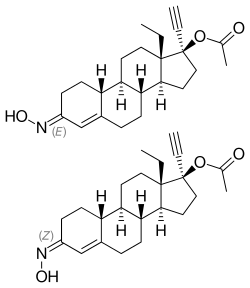Norgestimate
 | |
| Clinical data | |
|---|---|
| AHFS/Drugs.com | Micromedex Detailed Consumer Information |
| MedlinePlus | a601050 |
| ATC code | G03AA11 (WHO) G03FA13 (WHO) (only combinations with estrogens) |
| Legal status | |
| Legal status |
|
| Pharmacokinetic data | |
| Biological half-life | 12–30 hours |
| Identifiers | |
| |
| Synonyms | ORF-10131 |
| CAS Number |
35189-28-7 |
| PubChem (CID) | 6540478 |
| IUPHAR/BPS | 7091 |
| DrugBank |
DB00957 |
| ChemSpider |
5022837 |
| UNII |
C291HFX4DY |
| KEGG |
D05209 |
| ChEBI |
CHEBI:50815 |
| ChEMBL |
CHEMBL1200934 |
| Chemical and physical data | |
| Formula | C23H31NO3 |
| Molar mass | 369.497 g/mol |
| 3D model (Jmol) | Interactive image |
| |
| |
| | |
Norgestimate (INN, USAN, BAN) (brand names Ortho-Cyclen, Ortho Tri-Cyclen, Previfem, Sprintec, Prefest, others) is a steroidal progestin of the 19-nortestosterone group that is used in combination with ethinyl estradiol as an oral contraceptive and in combination with estradiol in menopausal hormone replacement therapy.[1] It is a prodrug, mainly of norelgestromin, but also of levonorgestrel in small amounts.[1][2]
Pharmacology
Norgestimate, unlike other 19-nortestosterone derivatives such as levonorgestrel, shows high selectivity for the progesterone receptor (PR) and low androgenic activity.[1][3] Moreover, norgestimate and its main active metabolite norelgestromin do not bind to or occupy sex hormone-binding globulin (SHBG).[1] In accordance, clinical trials of norgestimate have observed minimal androgenic side effects.[3]
Androgenic activity
The relative binding affinity of norgestimate and its metabolite norelgestromin for the rat prostatic androgen receptor (AR) are 0.3% and 1.3% of those of dihydrotestosterone (DHT), respectively, whereas the respective values for levonorgestrel and gestodene are 22.0% and 15.4%.[4] Moreover, the ratios of AR to PR binding are 219 for norgestimate and 48 for its metabolite norelgestromin, whereas the ratios of progesterone, levonorgestrel, and gestodene are 93, 11, and 28, respectively.[4]
Estrogens elevate and androgens suppress hepatic production of SHBG and by extension circulating SHBG levels.[4] Clinical studies have found that norgestimate does not appreciably inhibit the increase in SHBG levels produced by ethinyl estradiol, and this is in accordance with preclinical research and the notion that norgestimate is minimally androgenic.[4]
Norgestimate and norelgestromin show virtually no affinity for SHBG, unlike levonorgestrel and gestodene (which have 87% and 202% of the relative binding affinity of testosterone for SHBG, respectively) but similarly to progesterone.[4]
Pharmacokinetics
Norgestimate acts as a prodrug to norelgestromin (17β-deacetylnorgestimate or levonorgestrel 3-oxime), the primary active metabolite, and to a lesser extent to levonorgestrel (~22% of an administered dose; deacetylation of norgestimate occurs in the intestines and the liver), as well as to levonorgestrel 17β-acetate in very small quantities.[1][5][6]
Chemistry
Norgestimate is also known as norgestrel 17β-acetate 3-oxime (or simply norgestrel acetate oxime) or as 17α-ethynyl-18-methyl-19-nortestosterone 3-oxime 17β-acetate, and is the 3-oxime, 17β-acetate ester of norgestrel.
History
Norgestimate was introduced in 1986.[7]
See also
References
- 1 2 3 4 5 Thomas L. Lemke; David A. Williams (2008). Foye's Principles of Medicinal Chemistry. Lippincott Williams & Wilkins. pp. 1316–. ISBN 978-0-7817-6879-5.
- ↑ Tommaso Falcone; William W. Hurd (2007). Clinical Reproductive Medicine and Surgery. Elsevier Health Sciences. pp. 389–. ISBN 0-323-03309-1.
- 1 2 Chapdelaine A, Desmarais JL, Derman RJ (1989). "Clinical evidence of the minimal androgenic activity of norgestimate". Int. J. Fertil. 34 (5): 347–52. PMID 2571595.
- 1 2 3 4 5 Phillips A, Hahn DW, McGuire JL (1992). "Preclinical evaluation of norgestimate, a progestin with minimal androgenic activity". Am. J. Obstet. Gynecol. 167 (4 Pt 2): 1191–6. PMID 1415445.
- ↑ IARC Working Group on the Evaluation of Carcinogenic Risks to Humans; World Health Organization; International Agency for Research on Cancer (2007). Combined Estrogen-progestogen Contraceptives and Combined Estrogen-progestogen Menopausal Therapy. World Health Organization. pp. 150–151. ISBN 978-92-832-1291-1.
- ↑ Stanczyk FZ (2002). "Pharmacokinetics and potency of progestins used for hormone replacement therapy and contraception". Rev Endocr Metab Disord. 3 (3): 211–24. PMID 12215716.
- ↑ Benno Clemens Runnebaum; Thomas Rabe; Ludwig Kiesel (6 December 2012). Female Contraception: Update and Trends. Springer Science & Business Media. pp. 13–. ISBN 978-3-642-73790-9.